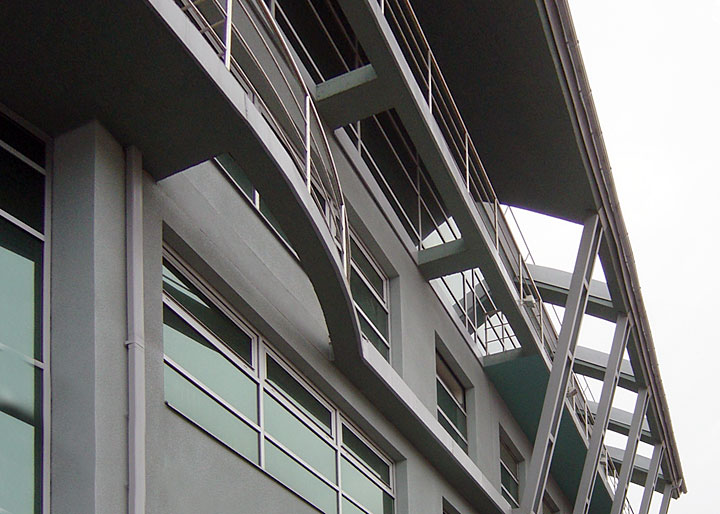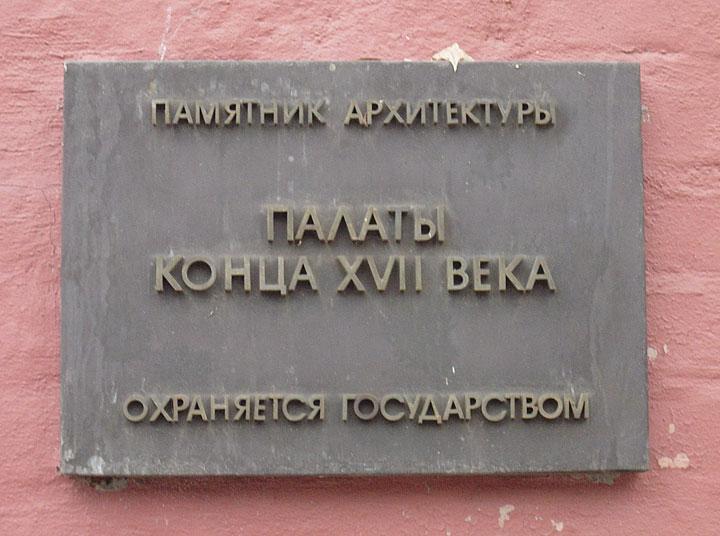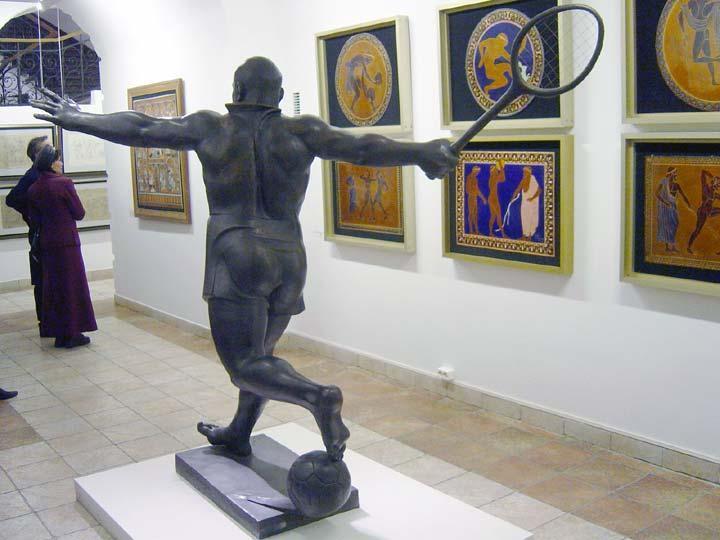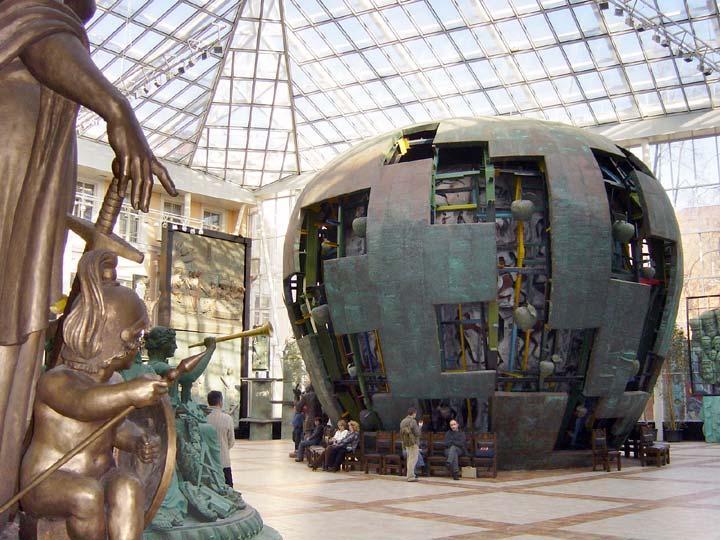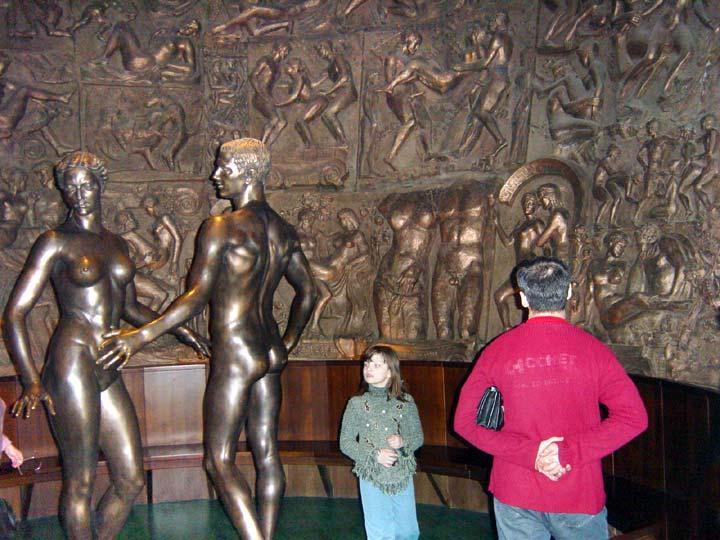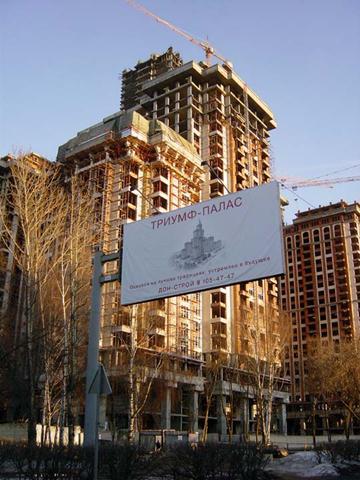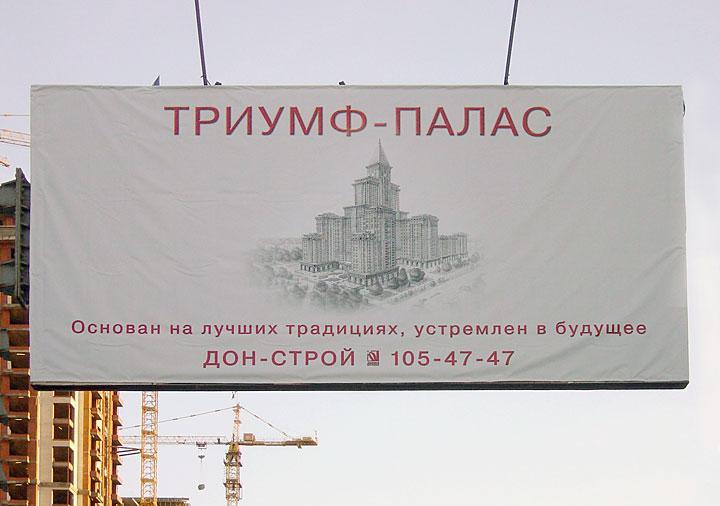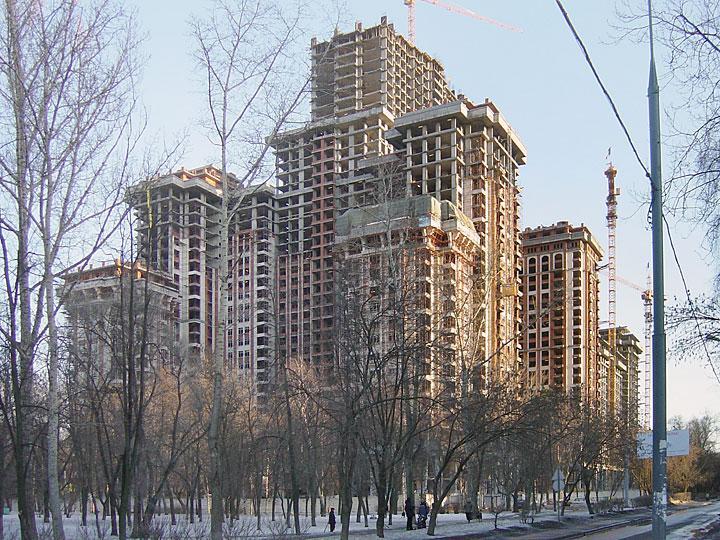Moscow Diary
In 2003, Vladimir Paperny was asked by the popular Moscow magazine “Afisha” (Billboard) to review contemporary architecture of Moscow. ARTMargins publishes Paperny’s conversations and street impressions.
March 26, 6:30 PM, “Afisha” Magazine
– Can you please write about the new architecture of Moscow, – asked the chief editor.
– I don’t know anything about it, you should ask Grigorii Revzin.
– He’s a professional, and we need a side perspective.
– A freewheeling essay?
– No, no, no—essays! We need the meat.
– Where am I going to get your meat? If only Revzin would agree to guide me around Moscow….
– We can’t call him, because he’s upset with us. But if you call him yourself, and he agrees, we can even pay him.
Revzin unexpectedly agrees:
– What are you talking about? Forget the money, I will gladly guide you for free.
March 27, 4:45 PM, Center of Modern Architecture
Director Irina Korob’ina introduces me to the architect Mikhail Khazanov:
– We are not only acquaintances, – said Misha, – but, as my mother asserts, even relatives.
Vigdariia Khazanova is a specialist in Russian architectural avant-garde. Her books and collections of documents were my main sources when I was writing my dissertation on Stalinist architecture. We never did figure out our relation, although in my grandfather’s stories her last name appeared more than once. Khazanova dedicated her life to the unrealized projects of the twenties. Now Misha is, in some sense, bringing to life that, which was not realized by the heroes of his mother’s books.
– Have you heard, Misha, that Revzin will guide Paperny around Moscow? – asked Irina. – Why aren’t you and me? Revzin won’t show him the right things. Let’s take him to Ostozhenka right away.
March 27th, 7:30 PM, Perechistenskie Gates Square
The dental clinic behind the statue of Engels, built by Mikhail Khazanov. It is made out of glass and concrete (supposedly), stainless (hopefully) steel, and gray cement combined with cold metal. It has the aesthetic of a war ship. Competent and elegant hi-tech lies next to the restored 17th-19th century chambers and to the Cathedral of Christ the Savior. A piece of Europe next to fake heritage. Or is it a piece of fake Europe next to authentic Asia? The client demanded antiquity, but Khazanov resisted and created modernity, even if from the last century. We already covered all that in the thirties. Why did we, all of the sudden, return to the starting point? Perhaps we never even left it?
Modern architecture quickly discredited itself in Russia, at first in the twenties because of the lack of cement (constructivist structures were built from brick and camouflaged to look like concrete), and later, because of Khrushchev’s shoddy barracks. In the same way, capitalism discredited itself in Russia at first by Lopakhins, cutting down cherry orchards, and a century later by gangsters in black Jeeps.
March 27, 8:30 PM, Ostozhenka
We walked for a long time over the wrecked yards and watery mud. This right here is the house built by the architect Skokan. This, as well as the one over there, is also Skokan’s house. And here is Skokan’s house right next to the Center of Galina Vishnevskaia, right across from two apartment buildings – by Posokhin and Meerson. All three buildings – Vishnevskaia’s Center, Posokhin’s, and Meerson’s – are amazing in their unrestricted carelessness, and loose combination of all possible styles. It’s reminiscent of the thirties. “Too soon did we switch to the slogan everything is permissible,” Victor Vesnin then said.
In comparison, Skokan’s house demonstrates good manners. It looks like Chekhov in his pince-nez, surrounded by merchants blowing their noses into the tablecloth. The façade is almost an exact rendition of what was there before. The courtyard is rather modern. This too is from the thirties. Facades facing the government routs were made to look antique. The courtyards were left blank. That’s why they looked like constructivism. Now one can pay her dues by rendering the façade antique, then the city will close its eyes to the modernist games in the courtyard.
The problem is, perhaps, that Russian architecture did not go through the modernism of Le Corbusier and Gropius. When in the sixties the borders opened up a little bit, and the architects rushed to master the forbidden “isms,” modernism was already getting shunned in the West. In order not to waste time, Russian architects left modernism and rushed into post-modernism almost the same way as they did in the past with communism, by skipping capitalism. The spatial language of modernism – one of the languages of contemporary architecture – has not been mastered. As a result, it is now much easier to create a la Shekhtel or Shchusev, rather than Le Corbusier.
In the twenties it was common to explain abstract geometrical compositions by purposefulness (“the city will be built on shock absorbers, in order to create an equilibrium; out of glass – in order to fill it with light, and up in the air, in order to free up the space” – wrote the LEF magazine about Lavinskii’s sketches for the city of the future). Now it’s not explained at all. It’s just that some architects in Moscow have an urge to join Europe. In most European cities there is a group of buildings based on the principles of abstract geometry. There is none in Russia.
The architectural gesture of Skokan, Khazanov, and other likeminded individuals, contains within itself an element of sacrifice: let’s step on the “throat of our own song”, to use Mayakovsky’s expression, but fill the void of the historical process.
March 27th, 8:30 PM, Aleksandr Skokan’s Studio
– For me, the concept of architectural gesture is very important, – says Aleksandr Skokan. – The building needs to enter the surrounding environment, like a person enters a room full of other people. One can enter, for instance, stomping one’s feet and yelling loudly, but it’s also possible to enter in a decent suit, modestly introduce oneself, and begin an intellectual conversation.
A noble idea. It’s clear that with an extravagant suit and a loud voice, one can attract more attention. According to Skokan, Eric Moss with Mariinskii Theater and Daniel Libeskind with The Twins, were acting inappropriately. But I don’t understand: what exactly is considered a decent suit? My Los Angeles neighbor, Eric Moss, also thinks that with his Mariinskii Theater project, looking like bags of cement, he started an intelligent conversation with the old St. Petersburg, and who can prove otherwise? This is a question of architectural language—a question Skokan discusses unwillingly.
– You have your own language and your own grammar, – I say, – you have, for instance, a few parallel metal pipes on the façade, and Moss would have bent all these pipes under different angles, something you would never do.
– No, – retorts Skokan, – everything depends on the context. In the context of Ostozhenka it would have been barbaric, but in another context, I would also be able to put these pipes under different angles.
– I heard that to obtain a building permit, one has to give a hundred thousand dollars worth of bribes. Do you have to bribe?
– Personally, I never bribed anyone. Everything is very organized now. In a budget given to the client there is a section titled “permissions”, and these permissions are obtained by specialists, or even whole organizations. A special sum is included, depending on what signatures need to be received. Every department has its own price. I was even told recently that my signature has a price—two thousand dollars. Naturally, I have never seen this money.
– So how much do the permissions cost?
– Here is an example for you. In my last project, seventy thousand dollars was in the budget for the design and a hundred thousand dollars for permissions.
So after all that, why go to the architectural school? It’s time to create a RAOP – Russian Academy of Obtaining Permissions.
March 29th, 11:30 AM, Chaplygin Street
– So what did Korob’ina showed you? – Revzin asks jealously.
– Ostozhenka, Khazanov, and Skokan. Do you have ideological disagreements with her?
– Not really. If you remember, I showed you Ostozhenka last year. It’s just that Irena is an architect, and I am an art historian. Skokan’s architecture is good European architecture, but in Europe, it would have never gotten printed in a magazine. I recently lived in the suburbs of Basel, there everything is filled with these Skokan-type houses. Yes, it’s civilized, but for an art historian, there is nothing to talk about.
March 29th, 11:45 AM, apartment building on Mashkov’s Street
 A red egg-shaped house, by architect Tkacheneko, a part of a larger residential structure. The idea of the egg shape was in the air for a few years. Marat Gel’man was going to build an eight-story-high maternity ward for the rich in the shape of an egg, where the happy parents would be given a real Faberge egg, along with their child. Why, all of the sudden, an egg? An egg is a source of life. For a maternity ward this carries some meaning, but for a single family home? Obviously the family is planning to procreate vigorously.
A red egg-shaped house, by architect Tkacheneko, a part of a larger residential structure. The idea of the egg shape was in the air for a few years. Marat Gel’man was going to build an eight-story-high maternity ward for the rich in the shape of an egg, where the happy parents would be given a real Faberge egg, along with their child. Why, all of the sudden, an egg? An egg is a source of life. For a maternity ward this carries some meaning, but for a single family home? Obviously the family is planning to procreate vigorously.
Anything can be said about Tkacheneko’s egg, except that it’s boring. It is by far not the “cowardly architecture,” as Karim Rashid called the modern Moscow buildings. The authors of the egg are not afraid of anything. Their house brings to mind a Faberge egg, a huge submarine with round portholes, a Kremlin tower, and a toy rocket. In Skokan’s terminology, a person has entered a hostile territory and wants to separate himself from it.
The recessed windows, according to the project, were supposed to be convex, mimicking the shape of an egg, but it turned out to be too expensive. The same problem arose with Khazanov’s Dental Clinic. The convex glass had to be replaced by the straight kind.
For a convincing gesture, an architect needs a wealthy patron.
March 29th, 12:15 PM, Department Store “Atrium” in front of the Kurskii Railway Station
– It’s a part of a whole program – to fill all Station Squares with department store buildings, – says Revzin. – A peculiar unpleasant edifice.
Warm pastel colors. Desert-like palette. Arches. This, in essence, is a theatrical decoration, put in front of another theatrical decoration. Kurskii Railway Station of the seventies was built in the style of Oscar Niemeyer. Now that modernism is considered passé, it is modestly covered up by thedepartment store building, built after an old Russian monastery, with galleries, arches, and an apsida – in a Syrian style, according to Revzin. A sharp turn from West to East . Niemeyer is, of course, from Brazil, but he was strongly influenced by Le Corbusier, which is why he’s still a symbol of westernization.
The next department store in Moscow will be built, I suppose, in the Baghdad style.
March 29th, 1:45 PM, Museum of Tseretelli
An unexpected discovery: Zurab Tseretelli is a good painter. On the other hand, his sculptures are a constant mixing of styles. For instance, he mixes a naturalistic head with an expressionistic body.
Tseretelli’s sculptural portraits of Luzhkov are reminiscent of Mihail Chemiakin’s allegories – with its cartoon style and verbosity. Luzhkov is playing both tennis and football – let’s stick a football to his foot and a tennis racquet to his hand. Chemiakin’s sculptural caricatures critique vice, while Tseretelli glorifies virtue. Luzhkov, in janitor’s garb, sweeps the garbage out of Moscow with a light post. Again, this is a verbal illustration to a thesis.
Actually, verbosity is a key word for understanding the art and architecture of Moscow in the past decade (or century, or millennium?). Verbosity flourished during Stalin’s Era, when every artwork, be it of literature or architecture, was required to have a verbal equivalent. The tiers of The Palace of Soviets, for instance, embodied the movement of political thought from the socialists-utopists to scientific Marxism. Tkachenko’s egg is built on the same principle; it is either a symbol of wealth (Faberge egg), or of fertility, but in either case it is a literary, not plastic, idea.
Today, the most unliterary architect is Aleksandr Skokan, but he seems to me especially un-Moscowlike, regardless of the fact that no one knows the history of Ostozhenka better than he does.
Moscow’s tradition consists of her barbaric destruction. Catherine the Great once noted that, in Russia, there can exist any kind of government except for a weak one. So it seems like today, in Moscow, there can exist any kind of architecture except for the boring kind. Here Chekhov’s tact is perceived as a weakness.
A sphere in the courtyard of Tseretelli’s museum—once again, an egg. Or is it an apple? Inside – erotic reliefs in Kama Sutra style. This is East, once again. A girl about six years old runs out of the egg and yells to her mother:
– Mommy, come quick, it’s SO beautiful in there!
“Everything is allowed,” as Victor Vesnin said. I am shocked when children have access to pornography. But I guess it’s just me. I recently completed a short film about Zinovii Zinik, a writer at a London club called “Colony Room,” where Zinik, while telling a story of the artist Francis Bacon said the words “his lover did him doggy style.” While giving this film to the NTV producer Ivetta Chernisheva, I say that the phrase probably needs to be cut out for the purposes of public broadcasting.
-You Americans are just like children, – says Ivetta. – A lover did him doggy style, and everyone gets scared.
March 29, 3:00 PM, The House of Music near the Krasnokholmskii Bridge
– It took a long time to build, – Revzin tells me. – The original project by Gnedovskii was rather in Luzhkov’s style. In essence, it was typical for Stalin’s era mixture of an old-Russian monastery and a Pantheon. At some point, they decided to modernize it. Architect Popov added a metallic hoop to the cylinder and Tseretelli donated a sculptural ring with a G clef, which was attached to the top. The resulting structure looks like a slow cooker, or a musical pot from Andersen’s fairy tales.
Gothic cathedrals were built across many centuries, and in them, one can see traces of different styles. However, the function and ideology changed little. A catholic cathedral could turn into a protestant one, but it remained a Christian cathedral. The uniqueness of Russian architecture consists of the fact that, function and ideology kept radically changing, and the edifices had to be constantly adjusted. In the 1920s, architect Chernyshev surrounded the Church of Serafim Sarovskii and Anna Kashinskaia (in Donskoi monastery) by a constructivist façade, and got a crematorium. The statue of Stalin, in front of the Mechanization Pavilion at the State Exhibition, was substituted for a rocket. It became Cosmos Pavilion, which was then painlessly turned into a store called “Everything for the Gardener.” The unfinished House of Soviets was multiplied seven-fold and arranged in a circle. One became an apartment building. Another – a ministry. The third one became a university. This multiplication reached its climax when in 1953 Grigorii Zakharov completed his project of reconstructing the Lusinovskaia Street, which he decorated with six identical, stepped skyscrapers, three on each side.
He was late. Right at that time Khrushchev’s fight with “architectural extravagance” (excessive decoration and ornamentation) had begun. It was hard to find a more convincing example of extravagance, and Zakharov was kicked out from all his posts. Nevertheless, he quickly adjusted and became a director of the Stoganov Art School. He even managed to erect an obelisk dedicated to war heroes (at the Kutuzovskii prospect intersection), in the form of a bayonet with a cut off point, decorated by a miniature spire with a star.
“Under the term architecture in Russia one understands the division of walls by lines, planes, and profiles, be it with ornaments, or without (which is not very important). This way, architecture became the art of theatrical decorations.” This was written in 1934 by a German architect Bruno Taut. Perhaps one could add “and decorating any edifice with cupola, towers, spires and stars”?
March 29, 4:00 PM, Paveletskii Railway Station Square
Perhaps the image of an egg of plenty is not accidental: the Palace of Soviets continues to multiply. Here is another new Stalinist high-rise without a spire. The story goes like this: In 1996, tells Revzin, Boris Uborevich-Borovsky won a competition, although with a completely different project. It was something akin to Tatlin’s Tower. The winner was forced into Tkachenko’s office, which at that time worked under Posokhin. So the official author of the edifice is Posokhin. At the last moment they decided to turn Tatlin’s Tower into a Stalinist high-rise, and put another tower on top—Kutafia, the only Kremlin tower without a spire. So Stalinism came out incomplete. It would have been better off with Spasskaia tower from Red Square.
The idea of putting something on top is blossoming. On top of the apartment building “Patriarch” (office of the same Tkachenko) they put precisely that Tatlin’s Tower. The statue of Lenin standing on the roof of the Palace of Soviets did bear some ideological meaning. Tatlin, on the Patriarch, bears none. The other part of the building is crowned with an arbor made out of wavy strips of steel that look like cookie cutters. I’m guessing it’s a hint that the inhabitants of the building like to eat well.
March 29, 5:20 PM, Triumph-Palace near Sokol
“Built on the best traditions, aspiring to the future,” states the ad for the building firm DON-stroi. The flyer itself is stylized after a document during Stalin’s Era, with discolored stamps and worn out edges. The fact that the creator of all DON-stroi buildings is an organization and not an individual is yet another nod toward Stalin’s Era of anonymity and facelessness. Who, for instance, today can name the creators of Stalinist high-rises? Perhaps only Grisha Revzin, and me.
– This is not completely a Stalinist high-rise, – explains Revzin. – This is a commercial structure. As you know, the best-sold apartments are located precisely in Stalinist houses. They have an aura of luxury, although in reality they’re extremely uncomfortable to live in. Now they have decided to build comfortable ones. In Stalinist high-rises, more than half the space is taken up by halls and vestibules. Here, the plan is very complicated; the living area is used very rationally.
Totalitarian symbol as a real estate advertisement – that’s cool. It’s the same as if one was to open a theme park ride called “Torture Chamber.” Or to promote a cruise across Siberia in a freight car with guards and guard dogs.
March 29, 6:45 PM, apartment building “Stol’nik” in Levshinskii lane
The last achievement of a creative group with a romantic name—“Art-blia” (which could be loosely translated as “Art-Dammit”). Although, they usually sign their architectural projects with the abbreviation AB.
– And don’t let Irina Korob’ina say that I didn’t show you progressive projects, – says Revzin, – although I personally don’t understand this one.
The name of the group seems to be peculiarly precise. The main volume of the house is reminiscent (in plan) of the Latin letter V. Because of that, Revzin thinks a lot of useful space disappears. In Stalin’s architecture, such space would have been taken up by halls and vestibules. Here, it’s taken up by nothing but Moscow’s polluted air. At the same time, the house attempts to portray a Corinthian capital, as if knitted with a crochet hook but from metallic tubes. It is something akin to a folk tablecloth with a fringe. In addition, it is decorated with parallel metallic profiles in the Art Deco style.
It is an interesting combination of mastery and cynicism. Everything is ridiculed here: classicism, modernism, post-modernism, Chekhov’s tact, and Lopakhin’s uncouthness. I would guess that while planning this building the authors were laughing. This laughter is contagious. It is a pagan release from totalitarian mores, while at the same time, from all mores. To me, the resident of a protestant country, this position appears to be destructive. What if we attach Petr Petrovich’s mustache to Ivan Ivanovich’s nose, as Gogol’ suggested? What if we combine Art-blia’s cheerful laughter with the selfless position of Aleksandr Skokan, or combine architecture-monologue with architecture-dialogue? I guess that doesn’t happen.
Great architects always destroy something in order to glorify themselves or their patrons. Bazhenov wanted to blow up Kremlin. Le Courbusier – the Historical Museum, and half of Moscow. The names of those who carefully preserved history didn’t preserve. However, there are exceptions. Our Californian architect Frank Gehry, whose name has already entered the history of architecture and is famous for his monologisms, recently decorated the interior of the Norton Simon Museum in Pasadena. The exhibits started to glow, but Gary himself is in the shade. He demonstrated almost Skokan-style modesty.
March 30, 11:00 AM, DON-stroi’s apartment building “Scarlet Sails” in Strogino
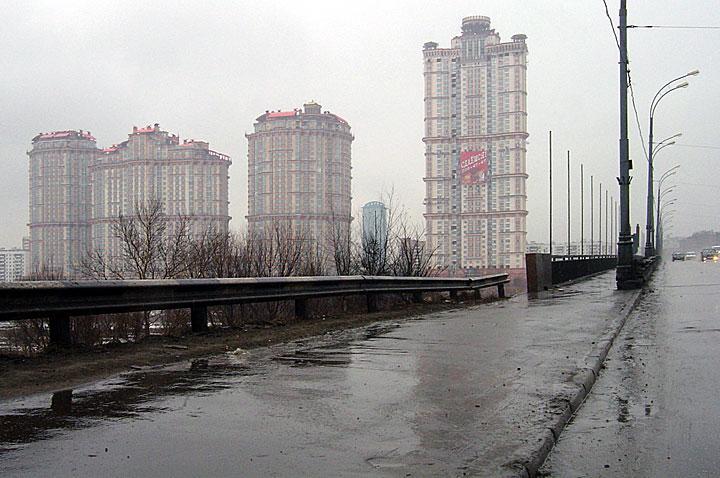 The name refers to Aleksandr Grin’s tale, a romantic story, in which the heroes have sonorous foreign names: Assol’, Gray, and Longren. Gray sails in the schooner with scarlet sails to take Assol away to a pretty life abroad. DON-stroi attracts customers with Stalin’s apartment complex standing on
The name refers to Aleksandr Grin’s tale, a romantic story, in which the heroes have sonorous foreign names: Assol’, Gray, and Longren. Gray sails in the schooner with scarlet sails to take Assol away to a pretty life abroad. DON-stroi attracts customers with Stalin’s apartment complex standing on
the shores of Moscow River. On its roof one can see some pieces of red steel. Inside are bowling and fitness center. DON-stroi missed a great advertising opportunity: it should have used the following excerpt from Grin’s “Scarlet Sails”:
“Happiness was like a soft kitten curled up inside of her. When Assol’ decided to open her eyes, the rocking of the rowboat, the sparkle of the waves, the huge, approaching, moving side of the ‘Secret’ – everything was a dream, where the light and the water bobbed and spun like sun-spots cavorting on a sunshine-streaked wall. She did not remember how she was carried up the gangplank in Gray’s strong arms. The deck, covered and draped with rugs, engulfed by the crimson splashing of the sails, was like a heavenly garden. And soon Assol saw that she was in a cabin – in a room, and there was nothing better than that room.”
March 30, 1:00 PM, DON-stroi’s apartment building on Teplichnyi Lane
 Teremok (a wodden Russian castle), whose lower part suddenly began growing and multiplying uncontrollably, turned into a skyscraper. The Teremok itself ended up hanging somewhere high above. It’s reminiscent of Baron Munchausen, who, while traveling in Siberia, tied his horse to a snowed pillar. In the morning, the snow melted and the horse ended up hanging high up in the sky, tied to a church cross.
Teremok (a wodden Russian castle), whose lower part suddenly began growing and multiplying uncontrollably, turned into a skyscraper. The Teremok itself ended up hanging somewhere high above. It’s reminiscent of Baron Munchausen, who, while traveling in Siberia, tied his horse to a snowed pillar. In the morning, the snow melted and the horse ended up hanging high up in the sky, tied to a church cross.
– Luzhkov’s style, – says Sergei Nikitin, a young historian who studied in Italy, – it’s the Turkish influence. Look around, everything is built by the Turks. Turkish building companies brought their own style with them, and it was welcome. This style of resort hotels of the third world countries. It doesn’t have anything to do either with old Russian architecture or with the eclecticism of the nineteenth century.
– You like Skokan’s style better?
– No, no, Skokan talks about Moscow traditions, at the same time mercilessly demolishing the old buildings and replacing them with his novelties. Soon there’ll be nothing left from Ostozhenka.
If so, this means that the conflict of modern Moscow architecture consists of the fight between Western and Eastern imitations. It looks like the East is winning, which confirms, once again, that a new “culture two” is coming. At the end of the 30’s, Iran was announced to be one of the favorite models for imitation. Now, it looks like it’s Turkey. The fact that Turkey became the favorite travel destination for the Muscovites apparently can’t be explained solely by economic factors. In Turkey and Egypt the Muscovites feel in their element.
April 5, 11:15 AM, Sheremet’evo Airport
“Out of Moscow! I’ll never come back here!” (Griboedov)
April 26, 10:30 AM, Los Angeles, the unfinished Music Hall by Frank Gehry
There is no ideological field around this building. No verbosity. Pure form. I’m missing something already. Isn’t it time to go to Moscow?
A Russian version of this text was published in “Afisha.”

